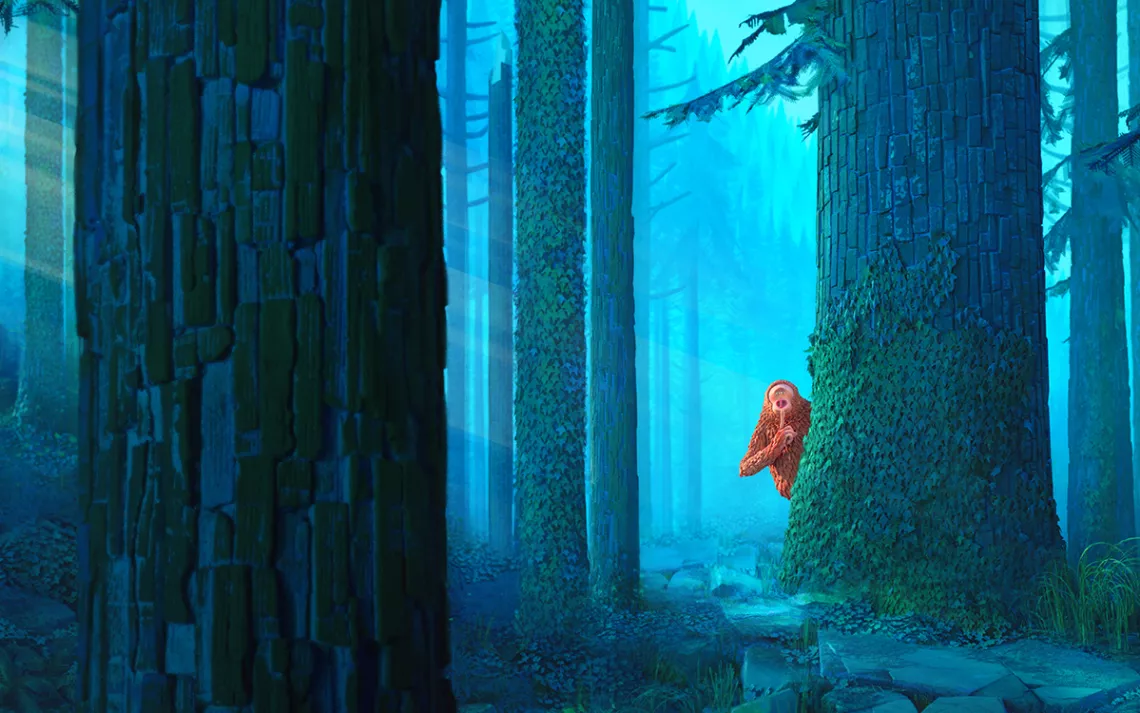“Missing Link” Explores Adventure’s True Purpose
The new kids’ film also has a choice message about evolution

Photos courtesy of Cakewalk Entertainment
Plenty of movies end in the culmination of a great quest. But the newest release from the stop-motion artisans at Laika Entertainment (responsible for goth-flavored kid flicks including Coraline and The Boxtrolls) starts with one . . . sort of.
Missing Link, in theaters now, offers a playful send-up of the brand of adventure specific to Victorian England, kicking off where else but in the Loch Ness lagoon. Aspiring monster hunter Sir Lionel Frost, a classically dashing wannabe-hero-among-myth-hunters voiced by Hugh Jackman, has dragged his manservant to the famed lagoon, where they’ve managed to lure the cryptozoological legend to the surface. Sir Lionel gleefully begins to take photos, prematurely savoring the respect he’s sure to earn from the snooty explorers and “great men” of London’s Optimates Club.
To formally join said society, members must document a major discovery. Alas, Nessie destroys the photographic evidence, leaving Sir Lionel embarrassed before the fusty old men who claim to advance scientific exploration but who reject Darwinian evolutionary theory. “We’re descended from great men, not great apes!” insists the Optimates’ priggish dean, Lord Piggot-Dunceby (Stephen Fry).
“I beg to disagree; I think we’re connected,” counters Sir Lionel, who, Nessie blunder be damned, remains convinced he can earn the Optimates’ respect by uncovering evidence of a “missing link” to our primal past. So when a letter arrives from the United States suggesting that the last surviving Bigfoot lives in Washington State, our hero sets out for the Pacific Northwest.
The 19th-century-era film is delightfully rife with relics of Victorian adventure lore—Sir Lionel relies on steamers, old-timey telescopes, parchment maps, bottle messages, and ornate trains to reach Washington. While Bigfoot’s existence has been a topic of debate for centuries, Sir Lionel promptly finds his “treasure” in the stunningly rendered pines of the world’s largest temperate rainforest ecoregion. The forest scenes, like others throughout the film, break ground visually by blending stop-motion pyrotechnics with 3D printing techniques.
This film's particular version of Bigfoot turns out to be a kind-hearted and desperately lonely 650-pound furball voiced by Zach Galifianakis. “Mr. Link,” as Sir Lionel dubs him after excitedly identifying the beast as a potential “missing link” between modern Homo sapiens and our primate ancestors, turns out to have been the letter’s sender. Mr. Link is hoping his dandy new British friend will take him to the Himalayas, where he can connect with some cold-weather cousins from the canons of monster lore, the Yeti. In a thought-provoking wrinkle regarding questions of identity, Mr. Link expresses a preference to be called “Susan,” after a lady prospector who was once nice to him.
Cocky though he may be, Sir Lionel differs from the generations of plundering colonial explorers before him in that he listens to his captive. Rather than having Sir Lionel make a trophy out of Susan, writer-director Chris Butler (of ParaNorman acclaim) foregrounds a more progressive narrative from this Victorian adventure. At its heart, Missing Link is a subtle evolutionary argument that centers around humans’ ability to change.
Cartoon mayhem ensues when Sir Lionel disguises Susan as a human and deputizes him as his personal valet, and the two set off on an adventure halfway around the world toward “Shangri-La,” presumed home of the Yetis. The conspicuous pair picks up another less-than-traditional adventurer companion following a failed attempt to steal a map from the strong-willed widow of Sir Lionel’s late partner in exploration. After giving Sir Lionel and his subjugating ways a piece of her mind, Adelina Fortnight (Zoe Saldana) insists on coming along for the quest.
As the trio journeys across Europe by train and India by elephant, Fortnight helps Sir Lionel evolve, if you will, by raising awareness of the complications caused by his sense of superiority—for always putting himself first, for making Susan into a porter, and for poking him with a stick. Susan may be a step behind on the evolutionary ladder, but Fortnight helps to humanize him.
When they finally reach Shangri-La and meet the snowy-furred, blue-skinned Yetis and their mean-spirited matriarch (Emma Thompson), our heroes must solve a series of puzzles that serve to unveil the true “missing link.” In a nod to the classic journey-trumps-destination trope, the ancient kingdom, while rendered stunningly, turns out to be not quite what it seems. Our heroes realize they need to rely on the bond they’ve developed—Sir Lionel’s first genuinely respectful relationship—if they are to survive the adventure.
Midway through the film, Sir Lionel says, “As long as I can remember, I wished to become a great adventurer, respected throughout the empire. It hasn’t quite worked out that way, but someday people will remember my deeds and know my name.” But after Susan’s own dreams of familial connection are crushed, Sir Lionel’s fear of becoming the laughing stock of Britain’s stuffy explorers shifts into perspective, and he comes to realize adventure isn’t about treasures excavated.
“Those men do not like or respect you or believe the things you believe, so why do you wish to become one of them?” Fortnight asks.
“Because they said I couldn’t.”
When some of the Optimates show up in the finale, Sir Lionel tells them, “I have evolved; I don’t want to be one of you,” to which they scoff, “But we’ve shaped the world.”
“I actually used to believe that,” Sir Lionel counters. “But now I believe the world shapes us.”
This gorgeously landscaped film makes for an artful fable. In addition to raising serious themes around loneliness and otherness, its sweet narrative uses a light touch to convey that it isn’t wanderlust that broadens one’s horizons—but rather, the mutual respect borne of friendship.
 The Magazine of The Sierra Club
The Magazine of The Sierra Club



